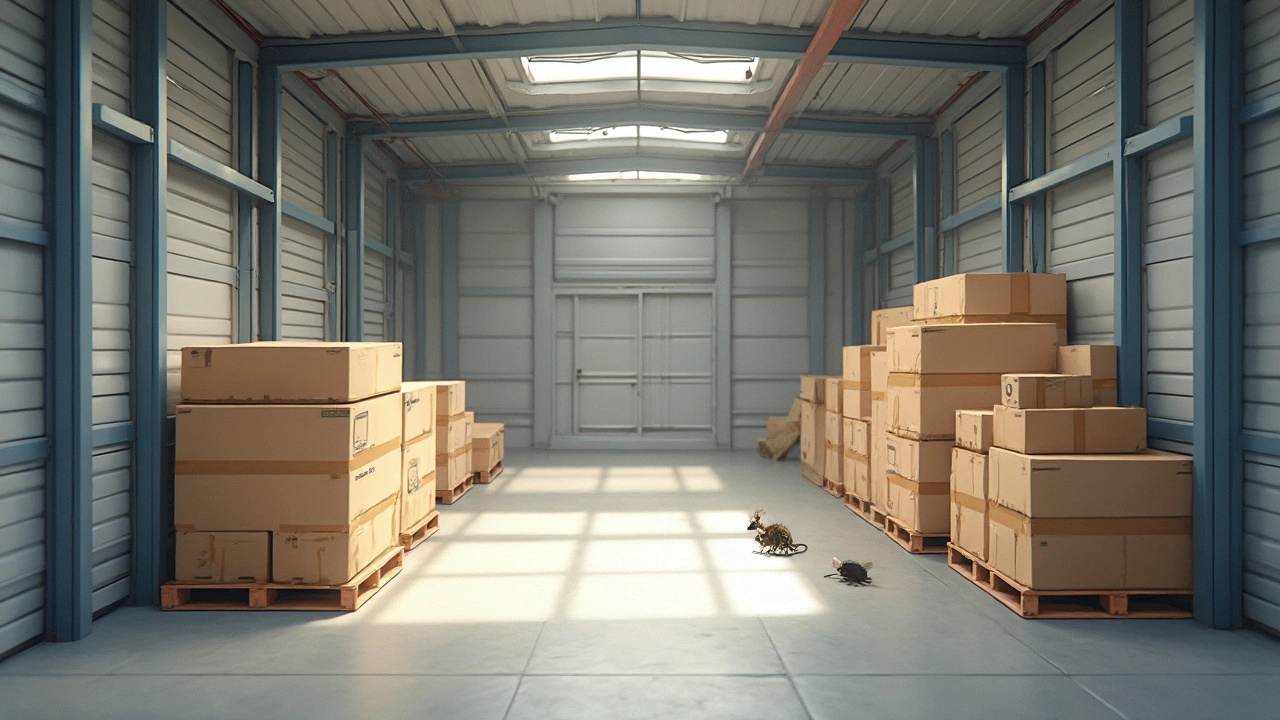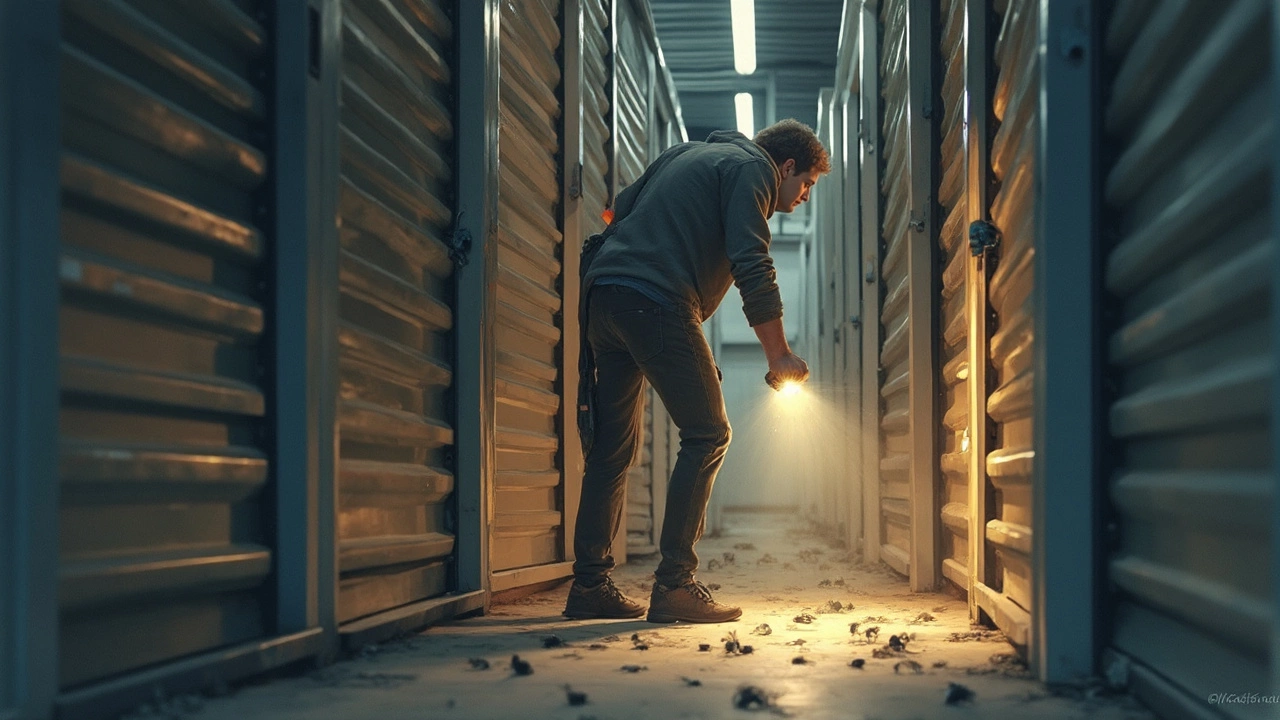
Mice and bugs don't care how neatly you've packed your boxes. They'll squeeze through tiny gaps or hitch a ride on cardboard without a second thought. The wild part? A mouse needs just a hole the size of a dime to get in. Roaches and silverfish can crawl through spaces you barely notice. The good news is, you can outsmart them with a few smart moves and a little attention to detail.
The number one thing that attracts pests is food. Even one forgotten snack, a crumb in a drawer, or a half-used scented candle can bring in unwanted guests. Seal anything that could attract pests or, better yet, don't store food at all. Use plastic totes instead of cardboard boxes. Cardboard is basically a buffet for bugs and a five-star hotel for mice looking to nest.
- How Pests Sneak Into Storage Units
- Packing for Pest-Proofing
- Practical Tips for Storage Unit Cleanliness
- Barrier Hacks and Pest Deterrents
- Checking and Maintaining Your Unit
How Pests Sneak Into Storage Units
Bugs and mice are experts at finding weak spots in any storage unit. Most people picture a lock on the door and think that's enough. Not even close. Mice, for example, can flatten their bodies and wriggle through a hole the size of a dime. Cockroaches can slip through cracks as thin as a credit card. These pests don’t need a big gap — just a little one.
The most common entry points are:
- Gaps under or around the door
- Cracks in the walls or floor
- Vents that aren’t screened
- Spaces where walls meet the ceiling
You probably won’t notice these spots during a quick look around. Mice follow walls to find gaps, and bugs are always looking for dark, moist places. Some pests can even come in when you move your stuff in — anything stored in a garage or basement is prime real estate for hitchhikers like spiders or silverfish.
Here’s a quick look at what can get into a typical storage unit:
| Pest | Smallest Entry Size | Most Likely Entry Point |
|---|---|---|
| Mouse | 0.25 inches | Base of door, wall corners |
| Cockroach | 0.07 inches | Floor cracks, gaps around pipes |
| Spider | Even smaller | Any unsealed crack |
If you’re near trees or dumpsters, expect more pest traffic. Bugs especially love dark and damp, so units that are close to the ground or have water leaks are even more attractive. When shopping around, ask the facility manager if they’ve had pest problems before. The answer might surprise you.
Packing for Pest-Proofing
The right packing routine can make or break your fight against pests. When loading up your storage unit, it's not just about stacking boxes—it's about forcing bugs and mice to look somewhere else for food and shelter.
First off, ditch the cardboard as much as possible. Cardboard boxes are almost irresistible to mice and bugs, and they soak up moisture, creating a breeding ground for all sorts of nasties. Instead, go for heavy-duty plastic bins with tight-fitting lids. A 2023 consumer report found plastic bins dropped pest complaints by about 60% compared to regular boxes. That's a game changer right there.
- Seal everything tight: Use bins with snap-on lids, or tape up any seams. Even a tiny gap is an invitation.
- Wrap soft items: For clothes, linens, or anything soft, use vacuum storage bags. They keep pests—and musty smells—out.
- Clean before you pack: Wipe down every item. No crumbs, no sticky spots, no surprise attractants.
- Add dryer sheets or cedar blocks: The smell can help throw off certain bugs and rodents, and it beats the smell of mothballs.
Don’t store food, candles, or even potpourri—it sounds obvious, but those things have a way of ending up in “miscellaneous” boxes. Empty out vacuum cleaner bags and make sure trash cans or laundry hampers are clean and dry. If you’re storing furniture, vacuum under cushions and in all the crevices, since old crumbs often hide there.
| Packing Material | Effectiveness Against Pests |
|---|---|
| Plastic Bins | High - rodents and bugs can't chew through easily |
| Cardboard Boxes | Low - attracts pests and absorbs moisture |
| Vacuum Storage Bags | High - airtight, blocks insects and rodents |
Finally, label everything. If you know what you packed and where, you’ll spot problems quicker. Plus, clearly labeled bins are faster to unpack, so you won’t be digging around and letting in bugs when you check your stuff.

Practical Tips for Storage Unit Cleanliness
Cleanliness is your best defense against storage unit pests. The less clutter and debris you have, the harder it is for bugs and mice to make themselves at home. Start by sweeping or vacuuming the unit floor before you move anything in. Even dust or tiny food scraps can pull in rodents and insects.
If you’re storing furniture or anything with cushions, make sure everything is wiped down and dry. Moisture draws in pests like silverfish, and even a small wet spot can set off mold growth. Mattresses and couch cushions? Use special plastic covers—they keep out both dirt and bugs better than fabric sheets.
Stick to plastic bins with tight lids for anything that’s not furniture. Cardboard boxes might be cheaper, but they’re a magnet for roaches and a dinner invitation for mice. Every year, storage facilities throw out hundreds of boxes due to pest damage. Don’t give bugs that chance.
- Double-check each bin or tub—snap the lids on and use tape if you need extra protection.
- Don’t store anything with food smells—pet food, scented candles, or even holiday popcorn tins.
- Line the unit’s floor with a simple plastic tarp or old shower curtain to stop moisture from seeping up.
If you visit your storage unit every few months, bring a broom and check corners. Spiders and silverfish love the spots you forget. Sweep up any debris, and toss out anything you no longer need—clutter just gives pests more places to hide.
| Common Storage Unit Attractants | What To Do Instead |
|---|---|
| Cardboard boxes | Plastic totes with lids |
| Upholstered furniture without covers | Plastic mattress and cushion covers |
| Pet food or scented items | Store only clean, scent-free items |
| Loose papers, clothes tossed on floor | Organize in sealed bins or bags |
Bottom line: keeping it clean makes a real difference when you want to keep bugs and mice out for good.
Barrier Hacks and Pest Deterrents
If you want to keep bugs and mice out of your storage unit, you need strong barriers and smart deterrents. Sealing up cracks is the first step—grab a tube of silicone caulk and go around the edges, focusing on where walls meet the floor and around the door. That dime-sized hole? Seal it up. Mice will squeeze right through if you don’t.
Add weather stripping to the door. Self-adhesive strips are cheap and easy to slap on, and they cut down the gaps pests use as secret entrances. If your storage place lets you, try a door sweep at the bottom for extra blockage.
Don’t store stuff directly on the floor. Pop everything up on shelves or pallets. It’s way harder for bugs and mice to hide when your boxes and totes are raised. Plus, you’ll spot any pest problem quicker. For the boxes, go with sealed plastic—not cardboard. Bugs can chew through cardboard, and it soaks up moisture, which attracts all sorts of creepy-crawlies.
For a simple natural deterrent, toss a few dryer sheets or cotton balls soaked in peppermint oil around your things. Mice and bugs seriously hate the smell. Some people even go for cedar blocks or mothballs, just make sure to use mothballs as directed—they’re not great to breathe in long term.
- Set glue traps or snap traps just inside the unit, hidden where pets or kids can’t reach. You’ll know right away if something sneaks in.
- For ongoing bug control, sprinkle a line of food-grade diatomaceous earth along the walls. It’s safe for people, but deadly to most insects.
- Go easy on scented items. Even candles or strong soaps can pull bugs through tiny cracks in search of food.
Some storage facilities offer monthly pest control. Ask about their policy and treatments. If they’re doing regular spraying and baiting, you’re way ahead in the pest battle.
| Entry Point Size | Common Pest |
|---|---|
| 1/4 inch (6mm) | Mice |
| 1/16 inch (1.5mm) | Ants |
| Any gap | Roaches |
Bottom line? The fewer gaps around your storage unit and the cleaner your stuff, the less likely you’ll find mice or bugs moving in. Take these steps now and you’ll save yourself a nasty surprise later.

Checking and Maintaining Your Unit
Even with the best packing and pest-proofing, regular checkups are your secret weapon. Pests can find new ways in, and sometimes little leaks or drafts can pop up that you’d miss if you never visit. Pop in every month or so, especially in spring and fall when mice and insects like to move around the most.
Start by giving the place a good look-over. Check corners, the spots behind boxes, and along the floor edges for any droppings, chewed packaging, or signs of bugs. Bring a flashlight. Mice are sneaky, and bugs like to hang out in dark, undisturbed spots.
If you see chewed holes in your boxes, spider webs, or even a pile of shredded paper, that’s a red flag. You’ll want to deal with it before things get worse. Call your storage unit manager right away if you spot any obvious pest signs. Most facilities will take action—sometimes they’re required by law.
- Keep a broom or small vacuum in your unit for a quick cleanup each visit. This gets rid of crumbs or debris that could attract pests.
- Double-check all your sealed totes for new gnaw marks or broken lids.
- Run your hands along the walls and doors to feel for hidden drafts or holes.
- If you can, rotate and move your stuff around every now and then. Pests love to settle where things never move.
Want to know if all your effort's working? Log what you see each visit—or snap a few pics as a quick memory check. And here’s a smart move: leave sticky traps or bait stations at floor edges and behind furniture. They’re a clear early warning if something's moving in when you’re not looking.
Facilities that perform routine pest control tend to have fewer problems. Ask your manager when was the last time the unit got sprayed or if they have regular pest checks—don’t just assume it's happening.
| Inspection Frequency | Pest Detected in Storage Units |
|---|---|
| Monthly | Less than 10% |
| Every 6 Months | Around 35% |
| Once a Year | Over 60% |
Regular visits make a difference. If you keep your storage unit well-checked and cleaned, your stuff is way less likely to get invaded by bugs or mice. It’s a small commitment for peace of mind.



